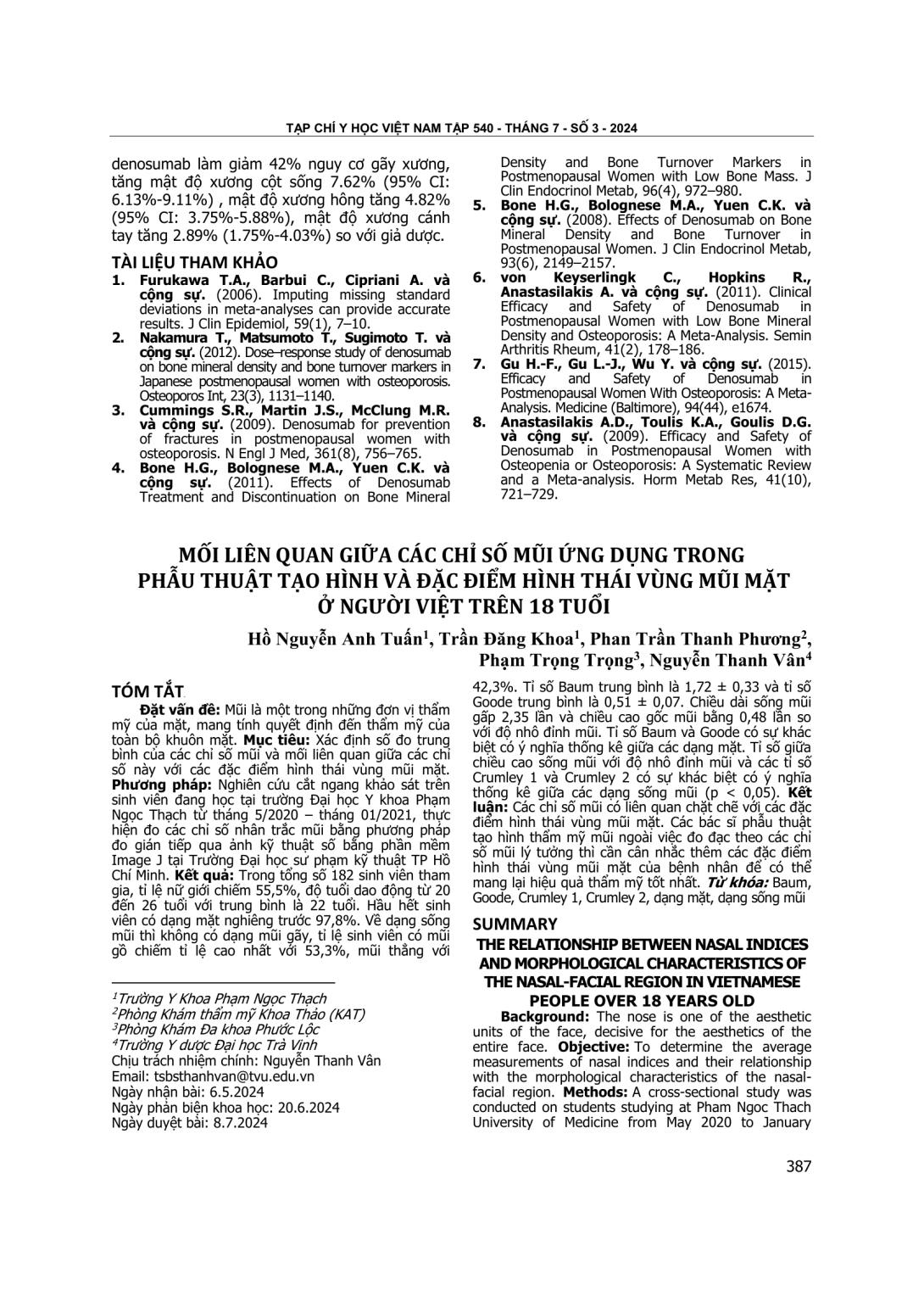
Mũi là một trong những đơn vị thẩm mỹ của mặt, mang tính quyết định đến thẩm mỹ của toàn bộ khuôn mặt. Mục tiêu: Xác định số đo trung bình của các chỉ số mũi và mối liên quan giữa các chỉ số này với các đặc điểm hình thái vùng mũi mặt. Phương pháp: Nghiên cứu cắt ngang khảo sát trên sinh viên đang học tại trường Đại học Y khoa Phạm Ngọc Thạch từ tháng 5/2020 – tháng 01/2021, thực hiện đo các chỉ số nhân trắc mũi bằng phương pháp đo gián tiếp qua ảnh kỹ thuật số bằng phần mềm Image J tại Trường Đại học sư phạm kỹ thuật TP Hồ Chí Minh. Kết quả: Trong tổng số 182 sinh viên tham gia, tỉ lệ nữ giới chiếm 55,5%, độ tuổi dao động từ 20 đến 26 tuổi với trung bình là 22 tuổi. Hầu hết sinh viên có dạng mặt nghiêng trước 97,8%. Về dạng sống mũi thì không có dạng mũi gãy, tỉ lệ sinh viên có mũi gồ chiếm tỉ lệ cao nhất với 53,3%, mũi thẳng với 42,3%. Tỉ số Baum trung bình là 1,72 ± 0,33 và tỉ số Goode trung bình là 0,51 ± 0,07. Chiều dài sống mũi gấp 2,35 lần và chiều cao gốc mũi bằng 0,48 lần so với độ nhô đỉnh mũi. Tỉ số Baum và Goode có sự khác biệt có ý nghĩa thống kê giữa các dạng mặt. Tỉ số giữa chiều cao sống mũi với độ nhô đỉnh mũi và các tỉ số Crumley 1 và Crumley 2 có sự khác biệt có ý nghĩa thống kê giữa các dạng sống mũi (p < 0,05). Kết luận: Các chỉ số mũi có liên quan chặt chẽ với các đặc điểm hình thái vùng mũi mặt. Các bác sĩ phẫu thuật tạo hình thẩm mỹ mũi ngoài việc đo đạc theo các chỉ số mũi lý tưởng thì cần cân nhắc thêm các đặc điểm hình thái vùng mũi mặt của bệnh nhân để có thể mang lại hiệu quả thẩm mỹ tốt nhất.
The nose is one of the aesthetic units of the face, decisive for the aesthetics of the entire face. Objective: To determine the average measurements of nasal indices and their relationship with the morphological characteristics of the nasal-facial region. Methods: A cross-sectional study was conducted on students studying at Pham Ngoc Thach University of Medicine from May 2020 to January 2021. Nasal anthropometric measurements were taken indirectly through digital images using Image J software at Ho Chi Minh City University of Technology and Education. Results: Among 182 participating students, 55.5% were female, with ages ranging from 20 to 26 years, and an average age of 22 years. Most students had an anteriorly inclined profile, accounting for 97.8%. Regarding nasal bridge types, there were no cases of a broken nose; the highest proportion was students with a convex nose at 53.3%, followed by a straight nose at 42.3%. The Baum ratio was 1.72 ± 0.33, and the Goode ratio was 0.51 ± 0.07. Compared to the nasal tip projection, the nasal bridge length is 2.35 times greater and the nasal root height is 0.48 times. The Baum and Goode ratios showed statistically significant differences among different facial types. The ratio of nasal bridge height to nasal tip projection and the Crumley 1 and Crumley 2 ratios showed statistically significant differences among different nasal bridge types (p < 0.05). Conclusion: Nasal indices are closely related to the morphological characteristics of the nasal-facial region. In addition to measuring ideal nasal indices, rhinoplasty surgeons should consider the morphological characteristics of the patient's nasal-facial region to achieve the best aesthetic outcome.
- Đăng nhập để gửi ý kiến
